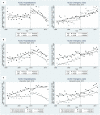Performing Through Privatization: An Ecological Natural Experiment of the Impact of the Swedish Free Choice Reform on Ambulatory Care Sensitive Conditions
- PMID: 34136446
- PMCID: PMC8200664
- DOI: 10.3389/fpubh.2021.504998
Performing Through Privatization: An Ecological Natural Experiment of the Impact of the Swedish Free Choice Reform on Ambulatory Care Sensitive Conditions
Abstract
Background: In 2010, Sweden opened up for establishment of privately owned primary health care providers, as part of a national Free Choice in Primary Health Care reform. The reform has been highly debated, and evidence on its effects is scarce. The present study therefore sought to evaluate whether the reform have impacted on primary health care service performance. Methods: This ecological register-based study used a natural experimental approach through an interrupted time series design. Data comprised the total adult population of the 21 counties of Sweden 2001-2009 (pre-intervention period) and 2010-2016 (post-intervention period). Hospitalizations and emergency department visits for ambulatory care sensitive conditions (ACSC) were used as indicators of primary health care performance. Segmented regression analysis was used to assess the effects of the reform, in Sweden as a whole, as well as compared between counties grouped by (i) change in private provision pre- to post reform; (ii) the timing of the implementation; and (iii) sustained presence of private providers both pre- and post-reform. Results: The results suggest that, following the introduction of the reform in Sweden as a whole, the trends in total hospitalizations rates were slowed down by 1.0% albeit acute emergency visits increased 1.1% more rapidly after the introduction of the reform. However, we found no evidence of more beneficial effects in counties where the reform had been implemented more ambitiously, specifically those with a larger increase in private primary care providers, or where the reform was introduced early and thus had longer time effects to emerge. Lastly, counties with a sustained high presence of private primary care providers displayed the least favorable development when it comes to ACSC. Conclusion: Taken together, the present study does not support that the Swedish Free Choice reform has improved performance of the primary care delivery system in Sweden, and suggests that high degree of private provision may involve worse performance and higher care burden for specialized health care. Further evaluations of the consequences of the reform are dire needed to provide a comprehensive picture of its intended and unintended impact on health care provision, delivery and results.
Keywords: Sweden; ambulatory care sensitive conditions; health system reform; interrupted time series analysis; natural experiment.
Copyright © 2021 Mosquera, San Sebastian, Burström, Hurtig and Gustafsson.
Conflict of interest statement
The authors declare that the research was conducted in the absence of any commercial or financial relationships that could be construed as a potential conflict of interest.
Figures


Similar articles
-
Fifteen years with patient choice and free establishment in Swedish primary healthcare: what do we know?Scand J Public Health. 2022 Nov;50(7):852-863. doi: 10.1177/14034948221095365. Epub 2022 May 20. Scand J Public Health. 2022. PMID: 35596549 Free PMC article. Review.
-
Evaluating the impact of the 2010 Swedish choice reform in primary health care on avoidable hospitalization and socioeconomic inequities: an interrupted time series analysis using register data.BMC Health Serv Res. 2024 Aug 23;24(1):972. doi: 10.1186/s12913-024-11434-w. BMC Health Serv Res. 2024. PMID: 39174988 Free PMC article.
-
A novel application of interrupted time series analysis to identify the impact of a primary health care reform on intersectional inequities in avoidable hospitalizations in the adult Swedish population.Soc Sci Med. 2024 Feb;343:116589. doi: 10.1016/j.socscimed.2024.116589. Epub 2024 Jan 12. Soc Sci Med. 2024. PMID: 38237285
-
Assessing the impact of the 2008 health reform in Ecuador on the performance of primary health care services: an interrupted time series analysis.Int J Equity Health. 2021 Jul 22;20(1):169. doi: 10.1186/s12939-021-01495-2. Int J Equity Health. 2021. PMID: 34294109 Free PMC article.
-
Equity aspects of the Primary Health Care Choice Reform in Sweden - a scoping review.Int J Equity Health. 2017 Jan 28;16(1):29. doi: 10.1186/s12939-017-0524-z. Int J Equity Health. 2017. PMID: 28129771 Free PMC article.
Cited by
-
Understanding primary care transformation and implications for ageing populations and health inequalities: a systematic scoping review of new models of primary health care in OECD countries and China.BMC Med. 2023 Aug 24;21(1):319. doi: 10.1186/s12916-023-03033-z. BMC Med. 2023. PMID: 37620865 Free PMC article.
-
Fifteen years with patient choice and free establishment in Swedish primary healthcare: what do we know?Scand J Public Health. 2022 Nov;50(7):852-863. doi: 10.1177/14034948221095365. Epub 2022 May 20. Scand J Public Health. 2022. PMID: 35596549 Free PMC article. Review.
-
Value-based care as a solution to resolve the open debate on public healthcare outsourcing in Europe: What do the available data say?Front Public Health. 2024 Oct 22;12:1484709. doi: 10.3389/fpubh.2024.1484709. eCollection 2024. Front Public Health. 2024. PMID: 39507667 Free PMC article.
-
More than meets the eye: a critical discourse analysis of a Swedish health system reform.BMC Health Serv Res. 2023 Nov 9;23(1):1226. doi: 10.1186/s12913-023-10212-4. BMC Health Serv Res. 2023. PMID: 37946232 Free PMC article.
-
Evaluating the impact of the 2010 Swedish choice reform in primary health care on avoidable hospitalization and socioeconomic inequities: an interrupted time series analysis using register data.BMC Health Serv Res. 2024 Aug 23;24(1):972. doi: 10.1186/s12913-024-11434-w. BMC Health Serv Res. 2024. PMID: 39174988 Free PMC article.
References
-
- Andersson F, Janlöv N, Rehnberg C. Konkurrens, kontrakt och kvalitet–hälso-och sjukvård i privat regi. Rapport till Expertgruppen för studier i offentlig ekonomi Finansdepartementet, Regeringskansliet (2014).
-
- Myndigheten för Vårdanalys. Vårdval och jämlik vård inom primätvården: En jämförande studie mellan tre landsting före och efter vårdvalets införande. Stockholm: Myndigheten för Vårdanalys; (2015).
-
- Winblad U, Isaksson D, Bergman P. Effekter av valfrihet inom hälso-och sjukvård: en kartläggning av kunskapsläget. Swedish Agency for Health and Care Services Analysis (2012).
Publication types
MeSH terms
LinkOut - more resources
Full Text Sources

